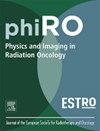基于深度学习的合成计算机断层成像在女性盆腔放疗规划中的应用
IF 3.3
Q2 ONCOLOGY
引用次数: 0
摘要
合成计算机断层扫描(sCT)需要提供仅磁共振放射治疗的电子密度信息。与其他sCT生成方法(如体积密度)相比,sCT生成的深度学习(DL)方法显示出更好的剂量一致性。本研究使用30个女性骨盆数据集来训练cyclegan启发的DL模型,发现变形计划CT (dCT)和sCT的平均剂量差异为0.2% (d98%)。三维伽玛分析显示,在1% /1mm处,平均为90.4%。该研究表明,常规T2自旋回波序列可以产生准确的sct(剂量),而无需额外的专业序列。本文章由计算机程序翻译,如有差异,请以英文原文为准。
Synthetic Computed Tomography generation using deep-learning for female pelvic radiotherapy planning
Synthetic Computed Tomography (sCT) is required to provide electron density information for MR-only radiotherapy. Deep-learning (DL) methods for sCT generation show improved dose congruence over other sCT generation methods (e.g. bulk density). Using 30 female pelvis datasets to train a cycleGAN-inspired DL model, this study found mean dose differences between a deformed planning CT (dCT) and sCT were 0.2 % (D98 %). Three Dimensional Gamma analysis showed a mean of 90.4 % at 1 %/1mm. This study showed accurate sCTs (dose) can be generated from routinely available T2 spin echo sequences without the need for additional specialist sequences.
求助全文
通过发布文献求助,成功后即可免费获取论文全文。
去求助
来源期刊

Physics and Imaging in Radiation Oncology
Physics and Astronomy-Radiation
CiteScore
5.30
自引率
18.90%
发文量
93
审稿时长
6 weeks
 求助内容:
求助内容: 应助结果提醒方式:
应助结果提醒方式:


